
Whether you have bugs, bats, or rodents invading your home, you’ll want to contact an exterminator quickly. Find out how much pest control costs in Columbus, OH.
Why earwigs are checking in—and how to make them check out


Food and shelter attract earwigs into your home.
These insects feast on houseplants, mold, mildew, decaying organic matter, and crumbs.
They seek shelter during the daytime in cold, dark places.
Remove wet piles of leaves, mulch, and wood from the outside of your home to prevent earwigs from setting up shop there.
If all else fails, an exterminator can remove earwigs.
Although they may look like tiny villains (with an unwarranted reputation to match), earwigs are less harmful than other bugs that make their way indoors. In most cases, earwigs are seeking food and shelter when the outside temperatures increase, which is what lures them inside.
If you’re wondering where all the earwigs are coming from, we explore what can be enticing them and how to give them the boot.
Without food and shelter, earwigs can’t survive. Which is why easy access to this duo can entice them to come from their natural habitat—outdoors—and into your cozy space. Here are the most common attractors of these pesky pincer-wielding insects.
Although they don’t primarily feast on crumbs or other food scraps like other bugs, earwigs can find food sources inside, especially if you have a plethora of plants.
Common “food” they’ll find indoors include:
Mold or mildew
Houseplants
Other insects
Pet food
Decaying organic matter
If desperate, crumbs or food scraps
Earwigs are nocturnal lawn pests, but when daylight strikes, they seek out cold, damp places that tend to go undisturbed. This is where your home comes in. Leaky pipes or unseen pooling water can easily attract earwigs, as can piles of wet mulch, leaves, or firewood.
Make sure any excess piles near your home, especially around windows, doors, and your foundation, are removed and any indoor plumbing issues are addressed to keep earwigs from setting up shop inside.

Earwigs can slip into your home through surprisingly small and common openings. Here’s how they’re likely getting inside:
Through cracks and gaps in window sills, walls, and door frames
Under doors with worn or missing weather stripping
In damp items brought indoors, such as potted plants, firewood, or newspapers
Through open doors and windows
In dryer or attic vents and bathroom exhausts
Through gaps around piping and cables
Check these areas regularly to make sure the entry points are sealed. That way, earwigs can seek shelter outside where they belong.
The best way to get rid of earwigs is to eliminate their source of food and shelter. Cleaning your kitchen regularly by wiping down surfaces and vacuuming up crumbs can ensure no scraps get swiped by these brown bugs. It also helps to check underneath your sinks for leaky pipes or pooling water that can attract earwigs inside.
If prevention methods don’t help, it’s time to call your local exterminator to inspect the property and implement a treatment plan. They can also help identify unsealed cracks or entry points that give earwigs easy access inside.
From average costs to expert advice, get all the answers you need to get your job done.

Whether you have bugs, bats, or rodents invading your home, you’ll want to contact an exterminator quickly. Find out how much pest control costs in Columbus, OH.

Tenting is a costly but effective way to exterminate termites. Learn the average termite tenting cost and everything that will factor into your budget.

The average roach exterminator cost is between $100 and $600, depending on the species, infestation severity, and home size. Read on for a cost breakdown.

If your dog brought some unwelcome pests into bed with you, learn how to get rid of fleas in bed before you’re covered in itchy bites.

Stink bugs are annoyingly persistent, but there are ways to fight back. Learn how to exterminate stink bugs in the house and prevent them from coming back.

Cockroaches are annoying, but German cockroaches are on another level. Here’s how to get rid of German cockroaches and when to call in an exterminator.